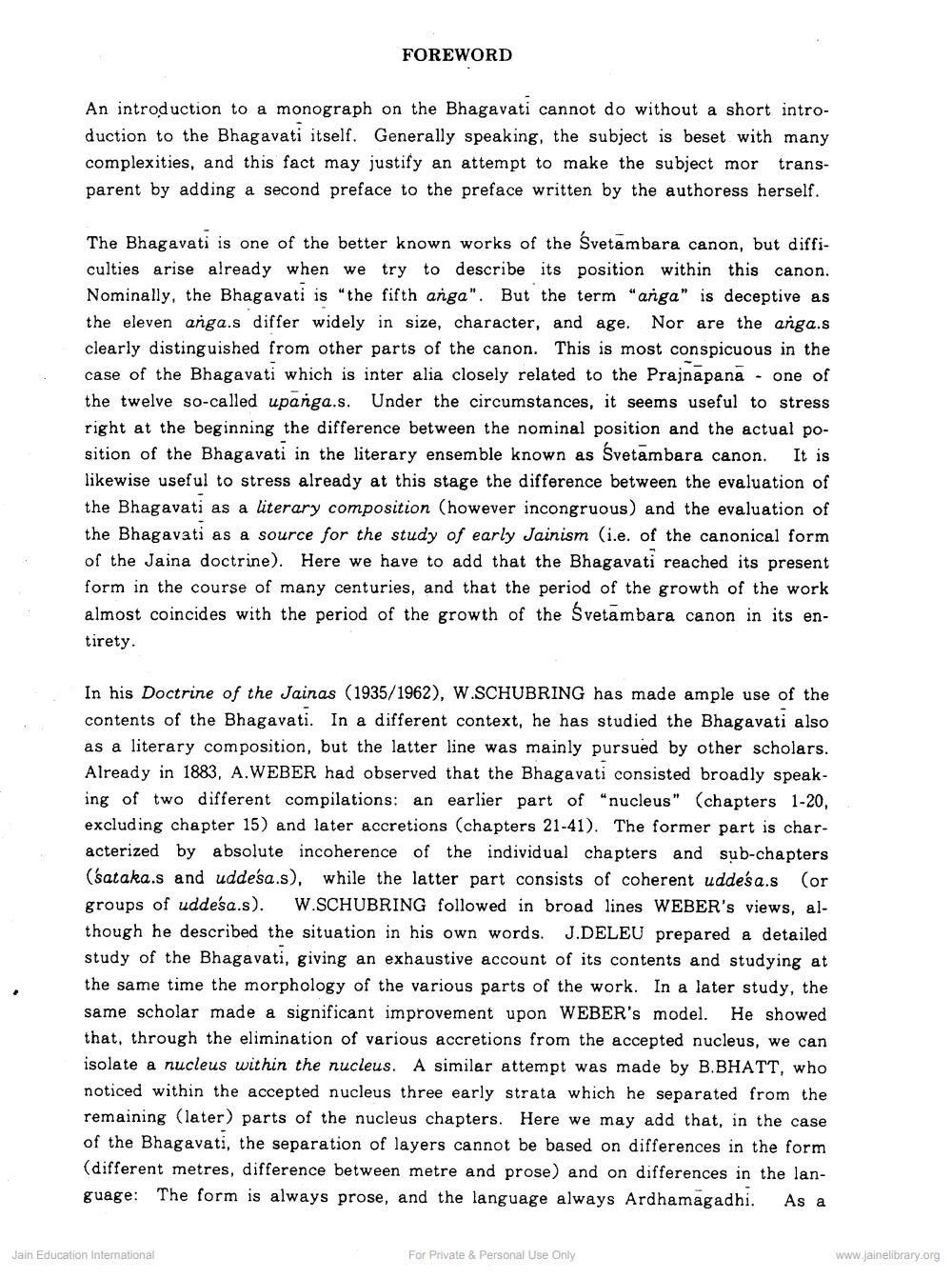Book Title: Agam 05 Ang 05 Study Of Bhagvati Vyakhya Prajnapti Sutra Author(s): Suzuko Ohira Publisher: Prakrit Text Society Ahmedabad View full book textPage 8
________________ FOREWORD An introduction to a monograph on the Bhagavati cannot do without a short introduction to the Bhagavati itself. Generally speaking, the subject is beset with many complexities, and this fact may justify an attempt to make the subject mor transparent by adding a second preface to the preface written by the authoress herself. The Bhagavati is one of the better known works of the Svetambara canon, but difficulties arise already when we try to describe its position within this canon. Nominally, the Bhagavati is "the fifth anga". But the term “anga" is deceptive as the eleven anga.s differ widely in size, character, and age. Nor are the anga.s clearly distinguished from other parts of the canon. This is most conspicuous in the case of the Bhagavati which is inter alia closely related to the Prajnapana - one of the twelve so-called upanga.s. Under the circumstances, it seems useful to stress right at the beginning the difference between the nominal position and the actual position of the Bhagavati in the literary ensemble known as Svetambara canon. It is likewise useful to stress already at this stage the difference between the evaluation of the Bhagavati as a literary composition (however incongruous) and the evaluation of the Bhagavati as a source for the study of early Jainism (i.e. of the canonical form of the Jaina doctrine). Here we have to add that the Bhagavati reached its present form in the course of many centuries, and that the period of the growth of the work almost coincides with the period of the growth of the Svetambara canon in its entirety. In his Doctrine of the Jainas (1935/1962), W.SCHUBRING has made ample use of the contents of the Bhagavati. In a different context, he has studied the Bhagavati also as a literary composition, but the latter line was mainly pursued by other scholars. Already in 1883, A.WEBER had observed that the Bhagavati consisted broadly speaking of two different compilations: an earlier part of "nucleus" (chapters 1-20, excluding chapter 15) and later accretions (chapters 21-41). The former part is characterized by absolute incoherence of the individual chapters and sub-chapters (sataka.s and uddesa.s), while the latter part consists of coherent uddesa.s (or groups of uddesa.s). W.SCHUBRING followed in broad lines WEBER's views, although he described the situation in his own words. J.DELEU prepared a detailed study of the Bhagavati, giving an exhaustive account of its contents and studying at the same time the morphology of the various parts of the work. In a later study, the same scholar made a significant improvement upon WEBER's model. He showed that, through the elimination of various accretions from the accepted nucleus, we can isolate a nucleus within the nucleus. A similar attempt was made by B.BHATT, who noticed within the accepted nucleus three early strata which he separated from the remaining (later) parts of the nucleus chapters. Here we may add that, in the case of the Bhagavati, the separation of layers cannot be based on differences in the form (different metres, difference between metre and prose) and on differences in the language: The form is always prose, and the language always Ardhamagadhi. As a Jain Education International For Private & Personal Use Only www.jainelibrary.orgPage Navigation
1 ... 6 7 8 9 10 11 12 13 14 15 16 17 18 19 20 21 22 23 24 25 26 27 28 29 30 31 32 33 34 35 36 37 38 39 40 41 42 43 44 45 46 47 48 49 50 51 52 53 54 55 56 57 58 59 60 61 62 63 64 65 66 67 68 69 70 71 72 73 74 75 76 77 78 79 80 81 82 ... 316
